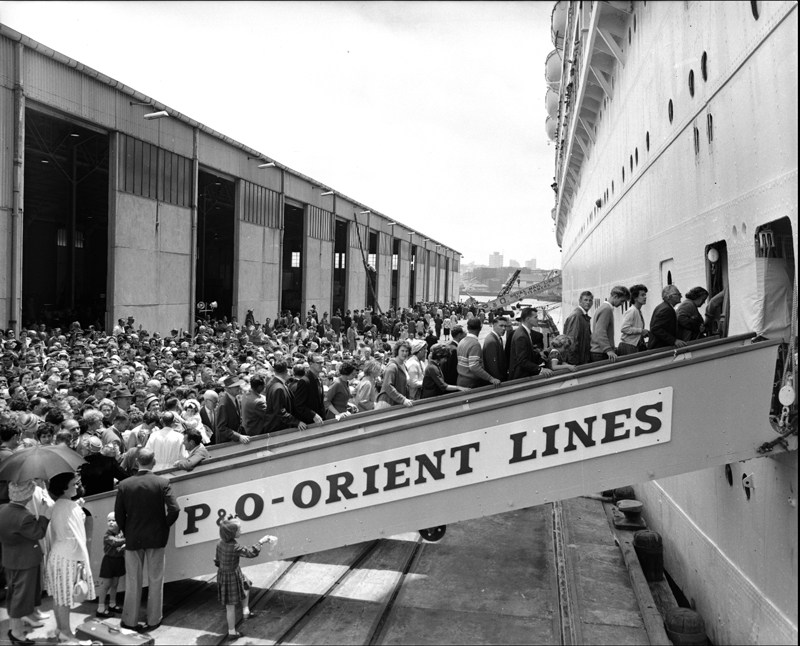
![assengers boarding a P&O liner c1950/1960s, ANMM Collection, ANMS1404[927]](https://s3-ap-southeast-2.amazonaws.com/anmm-data/blog/2015/11/05/anms1404927800px.jpg)
assengers boarding a P&O liner c1950/1960s, ANMM Collection, ANMS1404[927]
Documented are the crowds that flocked to the cruisers, either to sail on board or to celebrate the spectacle. Among the most historically significant of Gervais’ P&O images are a small set of aerial views of the SS Oriana arriving in Sydney Harbour on its first line voyage.
![SS Oriana arrives in Sydney Harbour 30 December 1960. ANMM Collection, ANMS1406[265]](https://s3-ap-southeast-2.amazonaws.com/anmm-data/blog/2015/11/05/ss-oriana-in-sydney-harbour-1-1960_800px.jpg)
SS Oriana arrives in Sydney Harbour 30 December 1960. ANMM Collection, ANMS1406[265]
![SS Oriana at the International Passenger Terminal, Sydney Cove. 30 December 1960, ANMM Collection, ANMS1406[283]](https://s3-ap-southeast-2.amazonaws.com/anmm-data/blog/2015/11/05/anms1406283.jpg)
SS Oriana at the International Passenger Terminal, Sydney Cove. 30 December 1960, ANMM Collection, ANMS1406[283]
This BBC Movietone news reel offers a flashback of Oriana’s approach to Sydney, highlighting the ship’s cost, size, speed and amenity.
Australia was symbolically incorporated into Oriana’s brand. Princess Alexandra of Kent, fresh from a visit to Australia, launched the ship using a bottle of Australian wine. A portrait of the Princess was also commissioned for the ship from an up-and-coming Australian painter, Judy Cassab (1920-2015).
In an interview with James Gleeson dated 1 January 1978, sourced from
the National Gallery of Australia, the late Judy Cassab* gives an amusing account of her experience. Cassab explains how a director of P&O bought a painting from her first solo exhibition in London (1959) and showed it to P&O Chairman, Sir Colin Anderson (also Chairman of the Tate Gallery Trustees). On her return to Sydney, informed of her inconceivable invitation to paint the Princess and sworn to secrecy, Cassab describes a letter she received:
‘Her Majesty The Queen has given you the yellow drawing room in Buckingham Palace as your studio’. It was ridiculous—they asked me how many sittings, and whether I was I sure I would be out of there by 22 April. I said, ‘Yes, I hope so.’ They said, ‘Because on the 23rd General de Gaulle is moving in’. Princess Alexandra came every day and changed and posed for me. She was infinitely patient and full of good will, saying, ‘Don’t worry if you don’t finish it. I will come up to the office of Orient Line and continue sitting for you’. But I did finish it.
Another Movietone newsreel from the day shows a few close-ups of some of the men who built Oriana and of the Princess.
But getting back to Gervais’ work, one of my personal favourites is a quirky promotional photo of a typical P&O bar. In perfect synchronisation the actors play-out a scene timed impeccably for the camera. Sadly for me, there were no images either side of this in the catalogue that hinted at a sequence, but perhaps, as more of the 3,000 images in the museum’s Gervais Purcell collection emerge, I will find others. For now I’m happy to imagine it as a single genius moment.

Promotional photo for a P&O bar scene c.1960, ANMM Collection, ANMS1406[318]
— Gemma Nardone
Footnote: At the time of sending this article to press I was saddened to hear of the death of Judy Cassab. Judy Cassab CBE AO came to Australia as a refugee of World War II and became one of this country’s most celebrated and influential Artists. A biography is available on the Australian Women’s’ Register.
